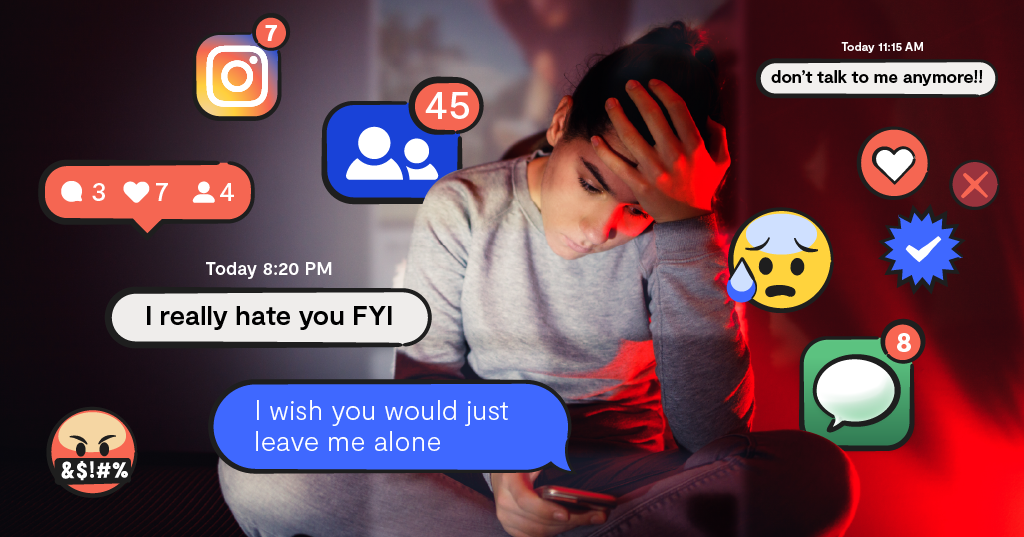
**This blog post was updated on May 6, 2022.**
The word “cyberbullying” has been around for a while, but at Bark, we’ve stopped using it. Instead, we just use “bullying,” because for kids today, the distinction between the digital world and the real world is gone. What happens online is no less real — or hurtful — as what happens in person. In this blog we delve deep into the question of how to deal with bullies.
For older generations, this can be kind of hard to understand. It may be easy to dismiss a mean Instagram comment or not understand the big deal about getting kicked out of a group chat. For Gen Z, though, the insult is all too real. Bullying in schools hasn’t changed, it just looks different. Because of this, it’s still a very serious threat to a lot of students. In this post, we’ll get you caught up on what to know about this common danger.
Bullying in Schools: What It Looks Like Today
Bullying used to happen in between classes, on the playground, or while riding the school bus home. Now, with smartphones, it can happen anywhere a kid goes. This makes it infinitely more troubling, because being away from school is no longer a temporary refuge. A child’s phone can ping with aggressive messages at the dinner table, in the backyard, or even in their own room.
There are so many ways for kids to taunt each other online. Active ways include sending aggressive and demeaning texts, emails, chats, and comments. Passive ways are things like posting a mean photo on Snapchat, for instance, that can be seen by hundreds of other kids in a matter of minutes. Virtual learning during the pandemic led to new forms of bullying, including Zoom bombing.
Bullying by the Numbers
Bullying is one of the most prevalent issues a child will face online. In 2021, we found that 72.09 % of tweens and 85.00% of teens have experienced bullying as a bully, victim, or witness. What did it look like? Examples ranged from mean-spirited teasing to hateful threats and provocations. It can also include creating fake accounts, impersonating someone, and even spreading nude photos.
It’s not just kids and parents who are worried about bullying, however. According to a recent Google survey, bullying is the number one online issue teachers worry about in the classroom. Sadly, only 46% of bullied students let an adult at school know what’s happening. While teachers can’t always see online bullying happen, (it can occur on private social media accounts) they can be witness to its after-effects. In students, this looks like moodiness, absenteeism, and even in-class disputes.
The Tragic Results of Extreme Bullying
Bullied kids are more likely to experience depression, anxiety, and low self-esteem. They also are more likely to be lonely and want to avoid school. And tragically, bullying can also lead to fatal consequences.
Megan Meier, a 13-year-old in Missouri, fell victim to a scheme when a fake profile of a teenage boy gave her false hope of a relationship. This type of online impersonation is called catfishing, and it can be devastating. Before long, the profile became a public forum for even more abuse toward Megan. It ultimately led to her death by suicide. Something similar happened to Phoebe Prince, a high schooler in New England. Six classmates were convicted for the roles they played in bullying her online.
Preventing Bullying In Schools: Beware of Legal Consequences
There is no federal law regarding cyberbullying, but most states have made some sort of effort to address this growing issue. Laws vary between states, but charges for online bullying can include civil law violations like defamation and harassment. Some states have explicit criminal laws against it, while others require school or district policies to be in place. At the end of the day, it’s important for students, families, and schools to know that bullying isn’t a harmless joke. It can seriously impact a child’s life for years to come.
Do Schools Do Enough To Prevent Bullying?
Stopbullying.gov recommends the following steps that teachers can take to help stop bullying:
- Speak privately with students who show signs of being bullied online, and collect proof if they have it.
- Report cyberbullying to parents and facilitate discussion between them, their children, and other school officials.
- Increase digital awareness to understand how students might abuse school-issued accounts.
- Develop activities that foster empathy, reflection, and self-regulation.
- Model, reinforce, and reward positive social behaviors.
- Encourage peer involvement in prevention strategies.
So, do schools do enough to prevent bullying? Preventing bullying and learning how to deal with bullies in schools is a crucial task, but manually sorting through every chat and email can be a daunting and overwhelming task for schools. That’s why we launched Bark for Schools, our community giveback program. Bark for Schools provides free monitoring of student accounts to help schools identify problems before they happen and reduce the dangers posed by school bullying, online predators, and more. Schools and parents receive timely alerts if something concerning happens so they can make sure everything’s okay and intervene, if necessary.
Read more
Bark helps families manage and protect their children’s digital lives.





